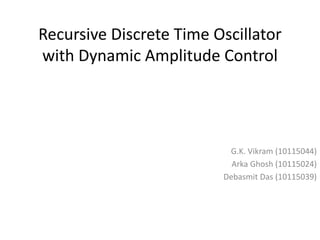Recursive Oscillators
- 1. Recursive Discrete Time Oscillator with Dynamic Amplitude Control G.K. Vikram (10115044) Arka Ghosh (10115024) Debasmit Das (10115039)
- 2. TWO ENTITIES âĒ Recursive Oscillator â It is a numerical oscillator which can be described by a recurrence relation. âĒ Dynamic amplitude control - The control technique used is Automatic Gain Control. It is used to encounter accidental instability.
- 4. STATE EQUATION |zI â A | = 0 and |z|=1 Yields the condition of a sustained oscillations - ad â bc =1 and | a+d | < 2 So these parameters determine whether the oscillator is stable .
- 7. a=0.5 , b=3, c=0.5 , d=0.6??
- 8. Calls for Automatic Gain Control âĒ Gain is tuned according to the amplitude of the signal âĒ If signal is weak then gain should be large and if signal is strong gain should be weak. âĒ Applications : Radio Sets , Amplifiers âĒ No Approximation of Gain required
- 11. REFERENCES âĒ Clay S. Turner , A Discrete Time Oscillator for a DSP based Radio âĒ Clay S. Turner, DSP Tips & Tricks, IEEE Signal Processing Magazine âĒ www.google.co.in
- 12. THANK YOU SPECIAL THANKS TO DR. P. SUMATHI












